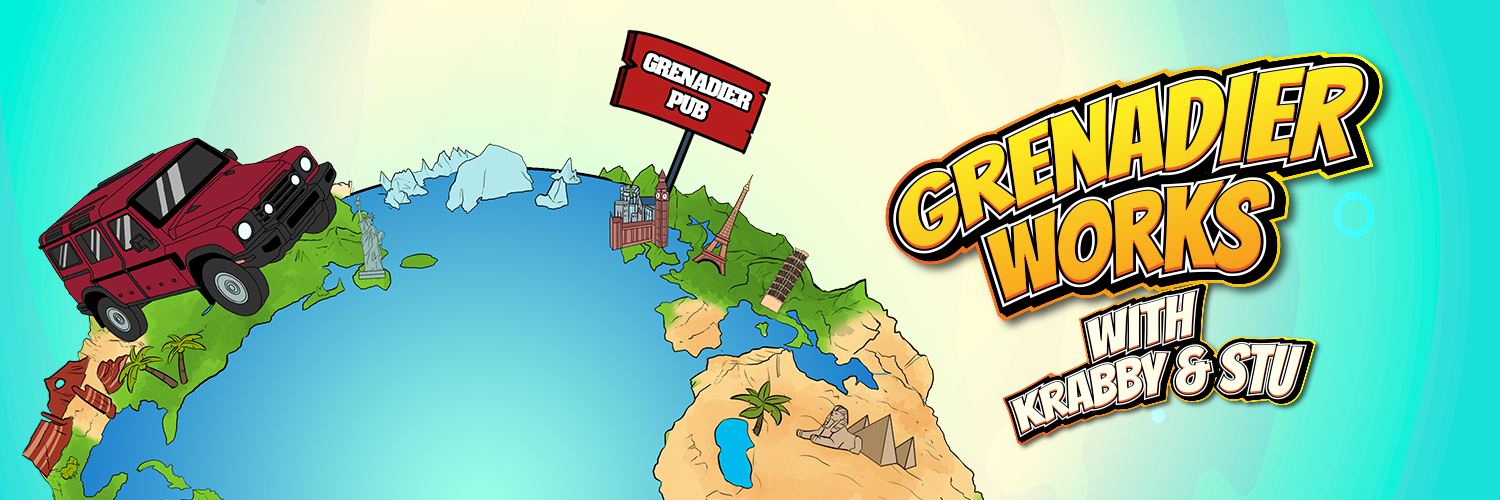The Jeep Cherokee uses a plunge style Rzeppa on the t-case side of the front driveshaft. That uses an accordion boot. I posted a picture of it earlier in this thread.Tom Woods walked because there is not a viable solution with only a drive shaft change. The angles at the at-Case are too extreme for a Double Cardan. And you can't use the acordian boot at the T-case as all the grease would migrate to the boot and cause balance issues. Also many drive shaft shops are not equipped to balance Rzeppa joint drive shafts. I offered to pay whatever it took to get Tom Woods tooled up for it. I also approached 2 other major US drive line shops including ones that can work with Rzeppa joints. They said it would not work and the best option was to retain the stock setup. But that they all acknowledge the boot might fail over time.
The Grenadier Forum
Register a free account today to become a member! Once signed in, you'll be able to contribute to the community by adding your own topics, posts, and connect with other members through your own private inbox! INEOS Agents, Dealers or Commercial vendors please contact admin@theineosforum.com for a commercial account.
You are using an out of date browser. It may not display this or other websites correctly.
You should upgrade or use an alternative browser.
You should upgrade or use an alternative browser.
The Jeep Cherokee uses a plunge style Rzeppa on the t-case side of the front driveshaft. That uses an accordion boot. I posted a picture of it earlier in this thread.
Best I can tell it's on the diff side of the front axle.
If the front case angle is that extreme, I'm guessing it points up at the front. Could not the driveline be shimmed with different mounts to "level" it, creating a better front angle at the expense of the rear shaft output?
Basically... 1) level the drivetrain 2) change the front shaft to a DC at the tcase, 3) change the rear shaft to a DC at the case 4) if needed adjust the rear pinion angle, which while more difficult than a leaf truck using shims, is still doable. i.e. Move the angle issue to the rear of the truck which has the axle we can work with.
Basically... 1) level the drivetrain 2) change the front shaft to a DC at the tcase, 3) change the rear shaft to a DC at the case 4) if needed adjust the rear pinion angle, which while more difficult than a leaf truck using shims, is still doable. i.e. Move the angle issue to the rear of the truck which has the axle we can work with.
Last edited:
It's not that the T- case points up at all on the front output, it's that the pinion almost points down. Literally if you set caster at 0° we wouldn't have a problem at all. Regardless, you would have to raise the T-case several inches to get any appreciable change and that would just make it worse.If the front case angle is that extreme, I'm guessing it points up at the front. Could not the driveline be shimmed with different mounts to "level" it, creating a better front angle at the expense of the rear shaft output?
Basically... 1) level the drivetrain 2) change the front shaft to a DC at the tcase, 3) change the rear shaft to a DC at the case 4) if needed adjust the rear pinion angle, which while more difficult than a leaf truck using shims, is still doable. i.e. Move the angle issue to the rear of the truck which has the axle we can work with.
I really don’t think you’d need several inches if all the mounts were adjusted. Also, it seems the tcase Cv is the one that’s failing not the pinion, or I’ve missed some pictures and complaints.It's not that the T- case points up at all on the front output, it's that the pinion almost points down. Literally if you set caster at 0° we wouldn't have a problem at all. Regardless, you would have to raise the T-case several inches to get any appreciable change and that would just make it worse.
I really don’t think you’d need several inches if all the mounts were adjusted. Also, it seems the tcase Cv is the one that’s failing not the pinion, or I’ve missed some pictures and complaints.
From the front motor mounts to the tarns/t-case mounts is a bit of a distance. I kind of agree that it would take several inches of shimming to appreciably change the front output angle. At that point we may be running out of room under the bonnet or under the floor. A cut and turn would probably get you a better angle at the transfer anyway despite the cost.
The whole thing is a phenomenal nothingburger.If the front case angle is that extreme, I'm guessing it points up at the front. Could not the driveline be shimmed with different mounts to "level" it, creating a better front angle at the expense of the rear shaft output?
Basically... 1) level the drivetrain 2) change the front shaft to a DC at the tcase, 3) change the rear shaft to a DC at the case 4) if needed adjust the rear pinion angle, which while more difficult than a leaf truck using shims, is still doable. i.e. Move the angle issue to the rear of the truck which has the axle we can work with.
EVERY 4x4 has the driveline canted towards the rear, including full-time Land Rovers, Jeeps, and Toyotas. I vividly remember the same discussion on some jeep boards and definitely on Land Rover boards 25 years ago.
The factory front driveshaft is fine. Likely, the vast majority (but not all) front driveshaft failures resulted from botched lift installs (driveshaft connected while front axle pushed away from the body). If someone found a way to have external boot on the factory driveshaft, there wouldn't be anything to talk about.
Don't reinvent the bicycle, unless you have some vested interest in unorthodox transportation.
One more failure without lift.
But I was just told this was one huge nothing burger.View attachment 7892095
One more failure without lift.
This is not the same as any rover, rovers have their pinion pointed too high or almost perfect depending on if your truck is lifted. Thats why the Double Cardan/single cardan shafts work so well on rovers. It's exactly what they are designed to do. The pinion gets a single Cardan since it's only a degree or so out of alignment with the shaft, and the transfer case gets the Double Cardan as it carries all the driveline angle. And since it's a radius arm suspension everything mostly stays in line throughout the travel.
This can be said about Toyotas with radius arms front ends but not for leaf sprung yotas.
Bottom line is the Grenadier setup is wonky and the accordion boot to my knowledge is not viable at the T-case side.
Last edited:
There goes the knowledge.This is not the same as any rover, rovers have their pinion pointed too high or almost perfect depending on if your truck is lifted.
Rovers pinion NEVER, ever, points perfectly (we're talking coil-sprung beam axle trucks). Rovers' driveline is canted back, about 1.5-2 degrees, hence the rear driveshaft that has one "poor man's CV" joint as Rotoflex and another regular U-joint.
Rover front pinion is never, ever, in line with the axis of the driveline. A Rover aficionado would know that the front axle runs on radius arms, so the more of spring lift, the worse is the situation. The front pinion angle can never be made right, with any lift; caster-correcting radius arms or bushings make the pinion closer to parallel with the front transfer case output, but at the expense of moving pinion down. The result of that is both U-joints (or CV/U-joint in a D2) working near the limit of their angle.
For whatever it's worth, this situation is exactly the same for G-Wagen and 80-series Land Cruiser, for they simply copied Rover suspension.
Nothing wrong with my LR Discovery 1 front or rear shafts after 400,000km with a lift and super flex Superior Engineering arms and no sway bars so super flex with 2 inch lift, dislocation cones and long travel shockers
Just saying…
Engineering failure and crap design somewhere
Just saying…
Engineering failure and crap design somewhere
Maybe you should go back and reread everything below what you quoted. I thought it was fairly clear without going into detail.There goes the knowledge.
Rovers pinion NEVER, ever, points perfectly (we're talking coil-sprung beam axle trucks). Rovers' driveline is canted back, about 1.5-2 degrees, hence the rear driveshaft that has one "poor man's CV" joint as Rotoflex and another regular U-joint.
Rover front pinion is never, ever, in line with the axis of the driveline. A Rover aficionado would know that the front axle runs on radius arms, so the more of spring lift, the worse is the situation. The front pinion angle can never be made right, with any lift; caster-correcting radius arms or bushings make the pinion closer to parallel with the front transfer case output, but at the expense of moving pinion down. The result of that is both U-joints (or CV/U-joint in a D2) working near the limit of their angle.
For whatever it's worth, this situation is exactly the same for G-Wagen and 80-series Land Cruiser, for they simply copied Rover suspension.
Im not the best person on here to pick a fight about Rovers etc.
Yep, the Defender and DI tended to do ok right up to about 2" lift even on stock drive shafts. They do like to eat Ujoints if you don't take good care of them. The front shaft from a Disco II will seriously reduce the potential for issues on the front shaft. If the front shaft goes it can tear a lot of stuff up.Nothing wrong with my LR Discovery 1 front or rear shafts after 400,000km with a lift and super flex Superior Engineering arms and no sway bars so super flex with 2 inch lift, dislocation cones and long travel shockers
Just saying…
Engineering failure and crap design somewhere
The rear of a DII has a rotoflex which is a bit of a mess, the inner bushings fail and the rubber gets trashed.
I replaced my rear drive shaft rubber joint long ago and replaced with uni joists as it continually tore itself to bits with all the articulation
The front was replaced years ago with a double Cardon set up to stop a slight vibration due to the lift.
A quick squirt with a grease gun every now and then and the uni joints last years
The front was replaced years ago with a double Cardon set up to stop a slight vibration due to the lift.
A quick squirt with a grease gun every now and then and the uni joints last years
My D1 was perfectly happy with 2" of lift, for all of 290k mi I had her. Not a hint of driveline vibration. Same for another D1 I had.Nothing wrong with my LR Discovery 1 front or rear shafts after 400,000km with a lift and super flex Superior Engineering arms and no sway bars so super flex with 2 inch lift, dislocation cones and long travel shockers
Just saying…
Engineering failure and crap design somewhere
I wish I could say the same about all of my Classics - nearly all of them have some, zero to 2" of lift.
Similar threads
- Replies
- 655
- Views
- 41K
- Replies
- 23
- Views
- 1K
- Replies
- 0
- Views
- 250



